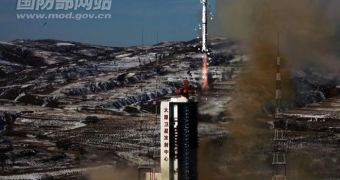For the first time ever, the China National Space Administration (CNSA) launched more rockets in a year than the United States did. The achievement was marked last Thursday, when the Asian nation successfully launched a new high-resolution mapping satellite in Earth's orbit.
This again highlights the growing ambitions that China has in space, both in LEO and beyond. The country has plans to build its own space station by 2020, and to put a person on the Moon by then.
There are also several robotic missions to launch, in addition to the usual satellite launches. The country is therefore keeping busy in this regard, and investing heavily in ensuring that it becomes a force to be reckoned with in this regard.
The rocket that beat the American record took off at 0326 GMT Thursday (10:26 pm EST Wednesday), December 22, from the Shanxi province-based Taiyuan launching base. The official news agency Xinhua reports that the spacecraft was installed aboard a Long March 4B delivery system.
It took about 13 minutes of flight for the rocket to reach its intended release coordinates, and deploy the Ziyuan-class satellite it was carrying. The Chinese defense ministry announced that the procedure went on flawlessly, Spaceflight Now reports.
All in all, the Asian nation had 19 launch attempts scheduled for this year, of which 18 were successful. The United States recorded just 17 launches, between all its major delivery systems – Atlas, Delta, Minotaur and Taurus, in addition to the space shuttle.
According to officials from both nations, there are no more launches scheduled for this year in any of the countries. China has all the reasons to be proud of its achievement, since it also marked another important event – breaking its own record for the number of launches carried out in a single year.
The previous record was set in 2010 when CNSA launched a total of 15 flights. This year saw it launch 4 rockets more, which is a very sharp increase. Most of these vehicles were used to deliver commercial satellites to orbit.
Two of them carried the Shenzhou 8 and Tiangong-1 modules, which managed to demonstrate that China is now capable of orbital docking. Next year will see a manned mission attempting such a maneuver as well.
However, both Chinese and US records pale in comparison to the 33 launches of Russian- and Ukrainian-built rockets, including Zenit, Progress and Soyuz vehicles. Three of these missions – none of them manned – ended in total or partial failure.

 14 DAY TRIAL //
14 DAY TRIAL //